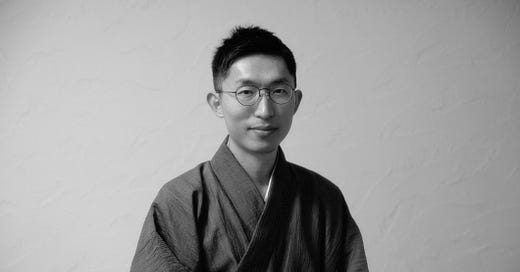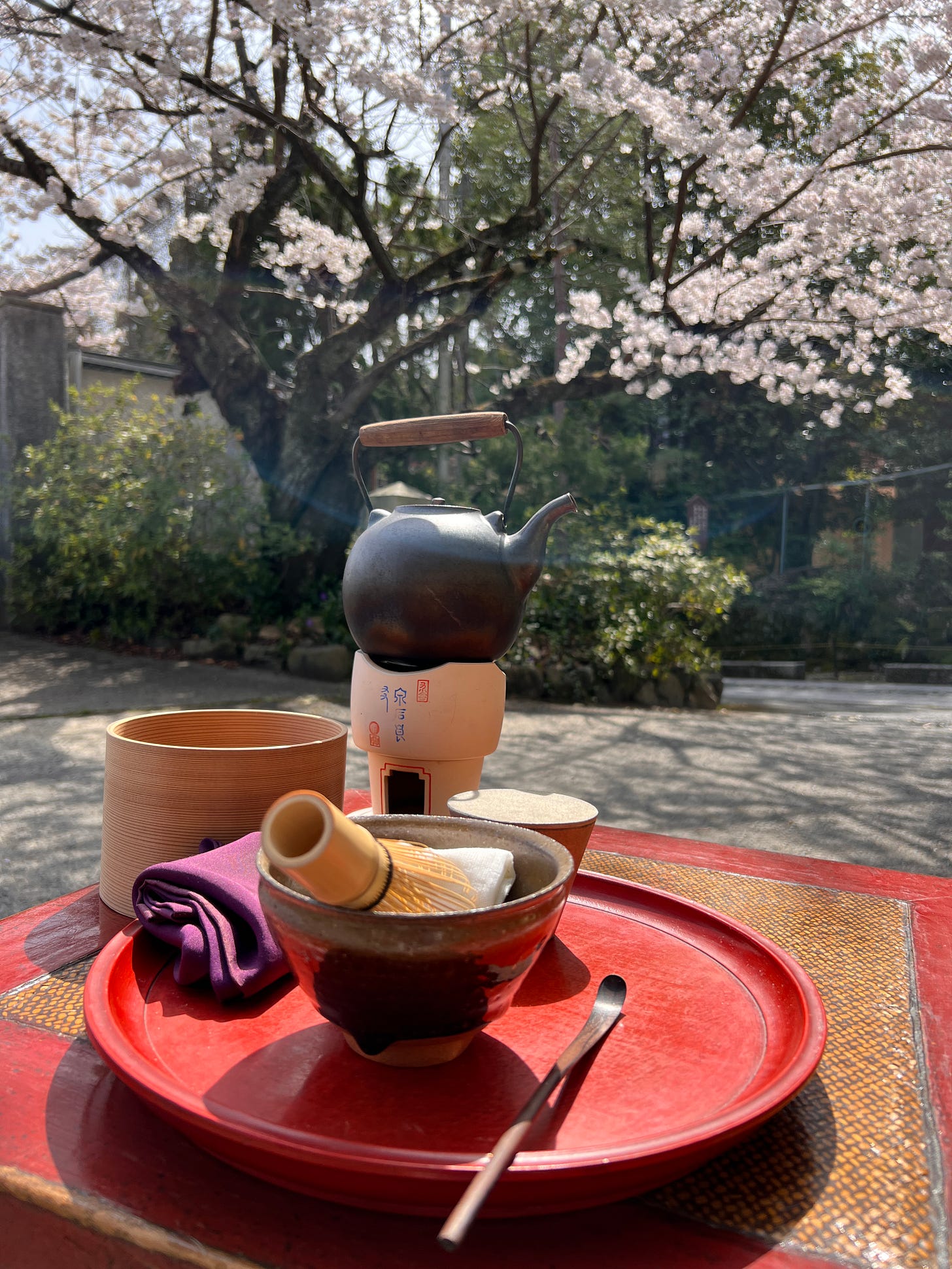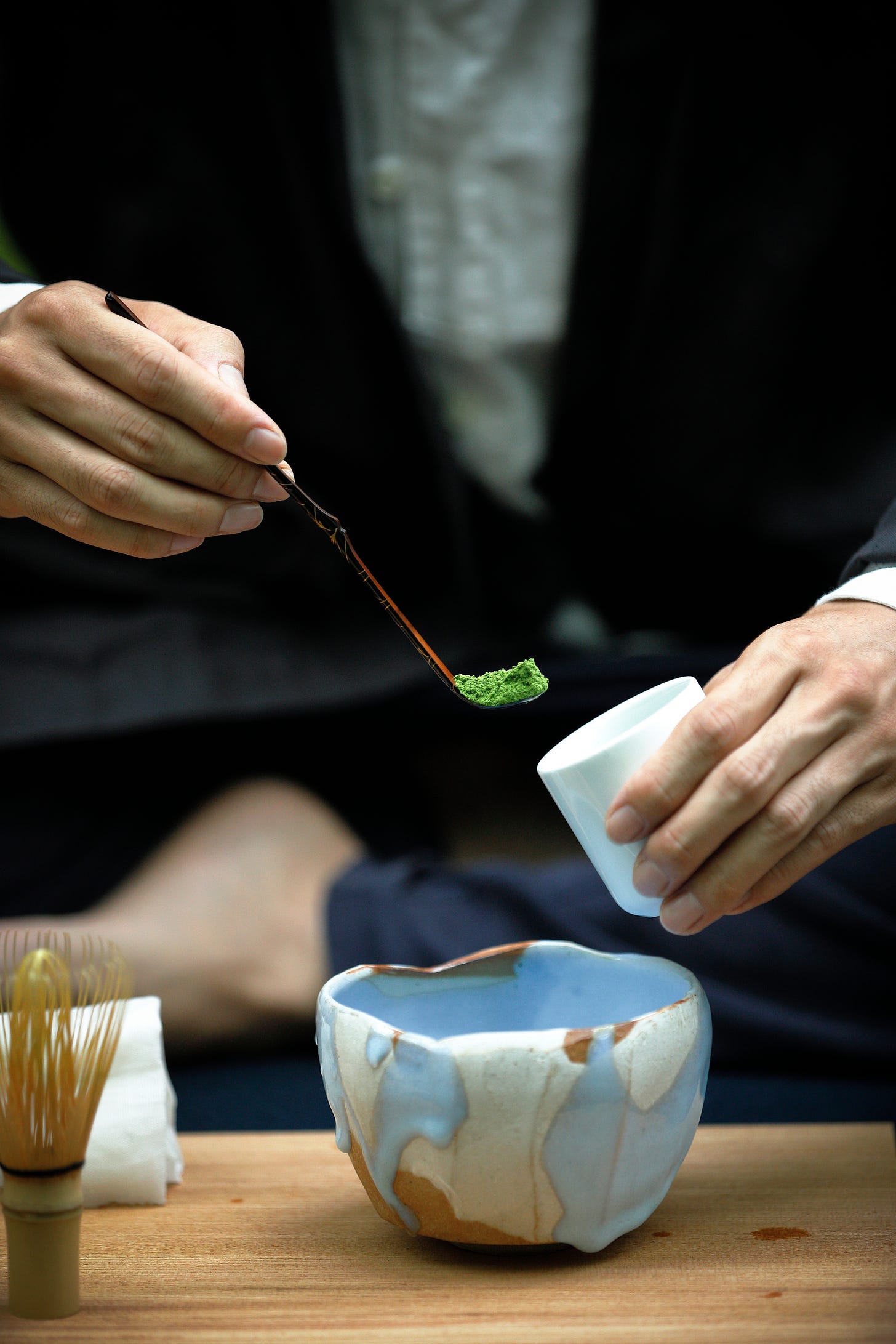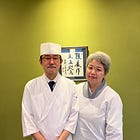#2 Conversations Mostly from Kyoto
Dairik Amae 天江大陸
“We tend to think of the artist’s work as the output.
The real work of the artist is a way of being in the world.”
-— Rick Rubin in The Creative ActIf it weren’t for tea with Dairik Amae, there might be no 72 Seasons of Tea. Through Japanese chadō, he opened the door to the vast world of tea for me.
I first met Dairik in January last year, just weeks after my unexpected hospitalization with a health diagnosis. The ground beneath me shifted, leaving me with a deep sense of uncertainty. I told him I was not sure what I was going to do next. “If you want to be a writer, you should just write,” he had suggested to me. Until then, I had only kept a private blog throughout my internship at the UN headquarters in New York and had not written a blog publicly.
Dairik is wise beyond his age and someone I respect. He is a multi-faceted person and would take chapters to be properly introduced. So here is a brief bio as he’s often introduced by others:
Dairik began his study of the Japanese Tea Ceremony at 19, supported by a background in Japanese architecture and design. Over the years he has lived in multiple countries including Korea, Russia, the United States, Syria, and Ukraine, shaping a globally informed approach to traditional Japanese arts. Now based in Kyoto, he continues his work in cultural practice, architecture, and design.
In his teahouse, time disappears. The world softens. In it is a space that immerses the senses, where time slows, and silence speaks — a space with an invitation for reconnection, where each element is in harmony. Here, the ordinary becomes sacred.
I am grateful to share the following conversation with you — a moment I had the privilege to experience with Dairik. And I hope that his journey inspires you as deeply as it has with me.
Why Kyoto, why tea?
When I first came to Kyoto as a university student of architecture, I was driven by my desire to promote traditional machiya townhouses — wooden homes handcrafted mainly using wood, mud (earthen) walls, bamboo, and paper — and preserve the cityscape shaped by centuries of skilled craftsmanship and carpentry.
But what I did not expect was how deeply the architecture of tea would then shape me.
At 19, I began taking Japanese chado lessons, drawn by the fascination with design and atmosphere of traditional tearooms. Every Sunday, I spent five hours with my teacher to focus entirely on tea, practicing the same motions repeatedly.
My teacher never told me that tea was meditation — only to concentrate on my tea making. But by my second year, something shifted. Tea began to be a kind of reset, a quiet space I could return to for clarity and reflection. I started to feel more natural and at ease with my tea-making.
By my third year, the boundaries between tea practice and my everyday life had blurred. I no longer practiced tea only on Sundays in my teacher’s space but I was making tea at home too. Even daily cleaning, cooking, studying began to feel like extensions of the same rhythm — deliberate and attentive.
I was beginning to carry what I had learned through tea into my way of life.
Why Kyoto, again?
After graduating from university, I moved to Tokyo for work, but gradually began to feel a quiet disconnection. I was no longer practicing tea nor arranging flowers (a core part of chado), both of which had anchored me.
“What makes me me? What was my mission?” At the same time that I started to question myself, a university friend invited me to collaborate on a shrine project back in Kyoto. It felt like a sign — a gut feeling I could not ignore despite my parents’ worries about me leaving behind a stable career in Tokyo.
Returning to Kyoto was inevitable. It was a return to myself — and in 2013, which is over a decade now, I followed that call home.
Since then, I have been living in a tea house that I had developed in Daitoku-ji, a temple complex deeply connected to the tea culture in Japan and closely linked to Sen no Rikyū and other respected tea masters.
My days are now centered in tea — boiling water, making a cup of tea, and with all its quiet and mindful preparation.
How is it living in Kyoto?
Living in Kyoto is much more comfortable than being in Tokyo, where I often found myself riding the last train home from the office.
Nature and people are what gives Kyoto its quiet charm.
Mountains on the horizon juxtaposed by moss-covered paths with the river running through the center of the city. Just a short drive away, the countryside unfolds, where people grow vegetables organically and live close to the rhythms of the land.
People in Kyoto are more laid-back and less market-driven. They may seem reserved at first, but connecting with the local culture reveals their genuine warmth. And there is a cozy creative energy here — among artists, diverse communities, including the thriving French expat circle. It is a place where one can live richly without needing to spend much.
I bike everywhere, walk often, and feel more rooted in the everyday.
How has Kyoto changed over the years?
After the 2011 Fukushima earthquake, many people — especially older generations and families with children — moved from Tokyo to Kyoto, more aware of the radiation risks affecting food and water they relied on in their daily life.
Similarly, a subsequent shock from the COVID-19 pandemic prompted a shift of a different kind. Younger people, including singles without families, began questioning the need for constant office presence.
Instead, many began seeking a slower, more thoughtful way of living — more like drinking tea, where taste, sensation, and the process matter, instead of chasing a quick caffeine fix. Kyoto, with its rich artistic culture and relaxed pace, offered such an alternative.
Kyoto became a place to enjoy simple, everyday things — meals, drinks, small moments. Meanwhile, Japan’s cultural appeal, from food, traditional culture, to anime subcultures, continued to attract inbound tourists. With the yen weakening and luxury hotels multiplying, Kyoto has transformed rapidly.
Yet this surge in tourism has also created distance. Locals seldom walk the same streets as tourists and rarely visit crowded landmarks like Kinkaku-ji or Fushimi Inari. What’s more worrying is the wave of traditional houses being demolished to make way for hotels and investment properties. Local families are selling homes and external buyers are reshaping neighborhoods. If this trend continues, Kyoto risks losing the very charm that makes it unlike any other city.
Any surprising encounters in your teahouse?
Zen Buddhism reminds us of our child-like nature — what it means to be arugamama, to accept things as they are and be honest with our emotions. In Japan, we call this honne: staying true to what lives in the heart.As kids, we would cry when we are hungry and smile once we are full. But as adults, we learn to suppress our raw and true emotions.
There has been a few times when guests, even adults, have unexpectedly begun to cry. I remember a family of four, including a teenage girl who, during the silence of the tea gathering, began to weep quietly.
“I’ve never felt this quiet and peaceful on this trip,” the girl had expressed in my teahouse. There was something in the space that allowed her to feel comforted without embarrassment — just held by its stillness.
As a tea practitioner, I want to share with others that the tea room is a safe space, a sanctuary. It is a place where political views, education, wealth can be left at the door, where we can remove our layers, identities, and just be present.
At its core, tea is beyond logic and it touches our heart directly.
What do tea and meditation mean to you?
This morning, peeling an apple became my quiet meditation — focusing on the sensation and texture as the knife glides through the fruit, requiring all attention to make each cut perfect.
Similarly, doing laundry, cleaning, taking out the trash, preparing charcoal for hot water — everything flows with each task unfolding with care. Even something as simple as noticing today’s weather and how it feels on the skin brings awareness to the body’s sensations.
It is about activating both body and mind in daily life. This, in essence, is what meditation is about. This, to me, is what tea is about.
How is dancing similar to meditating?
Once a month, I practice kagura, a Shinto dance with music and singing performed as a ritualistic offering to the Kami gods at shrines.
I became drawn to it by curiosity and a sense of connection with the local community. When I dance, my body comes first and logic follows after. It is a way for me to train my intuitive muscles and embrace a way of going with the flow while not being in control.
As a tea host, I place everything in perfect order, creating harmony from chaos — I control. In contrast, dancing is about moving to the music, like floating in water, letting the stream guide me — here, I surrender.
Dancing is also meditative, allowing me to enjoy wherever it leads. Kagura dance, like chado tea practice, is not about theatrically expressing emotions; it is about being in the moment and just doing it.
How do you navigate between following tradition and exploring new expressions in tea?
I often share with my students the three stages of progression called shu-ha-ri 守破離, used in various types of Japanese arts, from martial arts to chado.
Shu is the foundational stage, where you learn the fundamentals, protect the tradition, and carefully mimic your teacher — following the rules.
Ha is the second stage of deconstructing as curiosity grows and you begin questioning, even pushing against what you have been taught — breaking the rules.
Ri is the final stage of mastery, with departure comes freedom, when the artist is free to explore, sometimes even crossing into other mediums — transcending the rules.
This progression mirrors the arc of growing up: as children, we imitate our parents; as teenagers, we rebel; and as adults, we leave home to walk our own path. Traditional arts follow a similar rhythm. Beginners listen closely to their masters, but over time, a sense of individuality emerges — a kind of artistic ego that seeks to differentiate from one’s own master and explore life on one’s own terms.
Any advice for someone transitioning into the arts industry?
Today, the space of arts feels vast, yet increasingly commercialized. Even in art schools, the focus often shifts towards creating work that can be packaged and sold as a product. The lines between artist, designer, and salesperson have blurred —everything seems market-driven. Arts have become a business.
It is hard for me to advise as my approach is not shaped by the Western approach of productization but rooted in something more local, more lived.
I see art not as a separate activity, but as part of seikatsu bijutsu 生活美術 — a way of life where beauty and everyday living are intertwined.
Chado, the way of tea, is a way of life.
There is something deeply human within us that longs to be surrounded by beauty, where no computers nor artificial intelligence can replicate. We feel emotions when we encounter beauty because it stirs something deep down inside us, something greater than ourselves.
Beauty, to me, is both a virtue and a kind of wisdom. Not something to chase, but something already within — waiting to naturally flow when you live in tune with it. Beauty is not something out there to grasp, but in you to rediscover and to return to. Beauty is something you find within yourself.
For more information on Dairik Amae
Less is More - 1-min video clip for The Loss and Damage Coalition to address climate change
Emptying Our Cup - Interview with Musubi Academy
Quiet Moments: Finding Peace in the Ritual of Tea - Podcast by Ikigai Tribe










Peck Gee, thank you for such an amazing article. It’s a dream of mine to have the experience you had. I love when you wrote “In his teahouse, time disappears. The world softens. In it is a space that immerses the senses, where time slows, and silence speaks — a space with an invitation for reconnection, where each element is in harmony. “ Eternity flowed through me reading. 🙏🏽❤️
"There has been a few times when guests, even adults, have unexpectedly begun to cry." - that would be just like me to do that.... a great conversation, I learned a lot. 💖